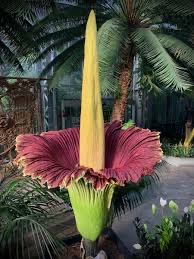Context:
People in Geelong city have beelined to witness an unusual event – the blooming of the Amorphophallus Titanum (called Titan Arum in short).

Relevance:
Facts for Prelims
Amorphophallus Titanum (Titan Arum)
- Known commonly as the Titan Arum or Corpse Flower.
- The plant was first described by the Italian botanist Odoardo Beccari in 1878.
Blooming Characteristics:
- The Titan Arum is notorious for its infrequent blooming cycle, typically flowering just once every decade. Each bloom lasts only 24 to 48 hours.
- During its fleeting bloom, the flower emits a strong odor reminiscent of rotting flesh. This scent attracts its primary pollinators—carnivorous bees and flies that normally feed on dead animals.
Physical Appearance:
- This plant can grow over 10 feet tall, making it one of the largest flowering structures in the world.
- It features a large, dark red spathe, which resembles an upturned meat skirt and a tall, crooked, pale yellowish spadix that looks phallic. The spathe is a spiral, petal-like structure that encloses the inflorescence.
- The interior of the spathe is dark red and resembles uncooked meat, enhancing its mimicry of a decaying corpse. The spadix even warms up to simulate the temperature of a warm, decomposing body.
Habitat:
- The Titan Arum naturally occurs on limestone hills within the rainforests of western Sumatra, Indonesia. In its native language, it is referred to as “bunga bangkai,” which translates to “corpse flower.”
Conservation Status:
- Classified as Endangered on the IUCN Red List, the Titan Arum faces threats primarily from habitat loss and the degradation of its natural rainforest environment.
-Source: The Hindu




